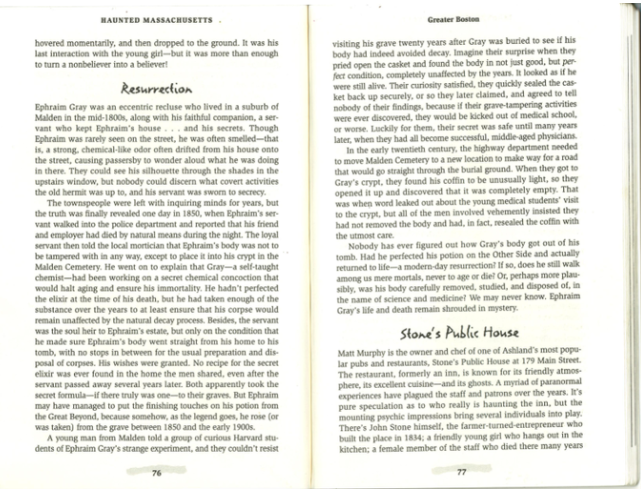
Excerpt from the book Haunted Massachusetts by Cheri Revai containing a version of the Ephraim Gray story. Photo submitted by Stephen Nedell.

You can’t run from the candyman.
Since school started up, there have been multiple sightings of the candymen. That’s right, candymen, plural. Roaming the halls and disturbing lunch tables, stopping by classrooms in between periods, taking shortcuts through open windows, you can’t escape them. They’re in every corner and staircase from Boyle to Brunelli. Just imagine this: it’s too hot in your classroom. You innocently ask your teacher to crack open the window. You wander into the hallway for a breath of fresh air. Before you know it, you fall victim to $2 Fritos (or Sour Patch, yikes!) and the perpetrator has escaped through the window! No one is safe….
By the way, an anonymous candyman wants everyone to know they don’t have change for 50s. It’s a candy business. They “don’t do that.”
“There are some days the cafeteria doesn’t have any food that I find appetizing and the candy business comes in clutch. The other day they saved me from starving during my math class with a bag of cookies, sour patch kids, and hot Cheetos. 5/5 stars would recommend.”
– Former Class of ‘22 President Jennifer Machado
On the topic of local legends, Ephraim Gray, or the Immortal Man of Malden, was a reclusive man who lived in the town in the 1800s. No one is sure whether he was born here, or if not, where he came from since the only person that he really talked to was his manservant, who he hired to deal with anything that had to do with social interaction. Gray spent most of his time in a big house in the center of town, focusing on his area of study, chemistry. His neighbors began noticing foul odors coming from the house but never cared enough to see what he was doing in there. Despite being an eccentric figure, Gray went largely unnoticed until his death sometime in the 1850s-60s. His manservant reported to the Malden Police Department that his master had died in his sleep, but this isn’t where the story ends. All along, Gray had been working on an elixir that would grant him immortality, but seeing that he had passed before perfecting the formula, his wishes were that his body be preserved and buried immediately with no embalming, autopsy, or dissecting. Gray believed that even though he failed to reach immortality in this lifetime, his experiments would at least allow for his body to be perfectly preserved. His corpse was transported to one of Malden’s cemeteries and placed in a mausoleum. Having no next of kin, Gray’s servant inherited his estate and all of his belongings. He lived in the home until he passed away only a few years later.
Fast forward to 1870, when the story of Ephraim Gray reached two Harvard medical students. They were curious to see if the rumors of Gray’s immortality were true, so they made their way to the cemetery in the middle of the night, breaking into the crypt. When the students pried off the lid of Gray’s coffin, they were stunned to find a corpse with not a single trace of rot or death, even after nearly two decades. Shocked, they resealed the coffin and left. This was the version they told people. Another story claims that one of the medical students brought a saw that they used to cut off Gray’s head, but something scared him in the process causing all of them to run off, leaving the body and severed head behind.
In 1900, the cemetery was relocated for the construction of new roads, which required Gray’s tomb to be moved to a new location. When the workers came to move his body, they realized that his coffin was lighter than normal. Opening it up, they discovered that it was empty.
Now, what do you think happened to Ephraim Gray? Did he even exist in the first place? Did his formula work but take years to kick in? The earliest record of this story comes from Folklorist and Harvard student Edward Rowe Snow (1902-1982), who claimed that the medical students did in fact remove the corpse’s head. They heard moans and footsteps within the tomb that scared them away, leaving them to abandon Gray’s body. He mentioned that after this incident, the tomb door was known to fling open at the stroke of twelve, revealing the body of Gray crawling out of his coffin and wandering the cemetery, supposedly in search of his head. Very Sleepy Hollow-esque…
From a factual standpoint, there are no records on an Ephraim Gray (or Graves, as he is sometimes referred to) in the Births, Marriages, and Deaths of Malden, Massachusetts book which documents residents from 1649-1850. There are a few Grays in there, but none with the same first name as our mysterious fellow. It is very likely that Ephraim was born outside of Malden, and his exact death date could have been after 1850, excluding him from these records.
The interesting part about the cemeteries in Malden is that all four of the current-day ones (Holy Cross, Forestdale, Maplewood, and St. Mary’s), were all established after 1851, meaning that Gray’s body and records could have easily been lost in the process of renovation. As far as history says, Ephraim Gray did not exist. There are no records of birth or death, pictures of his house or gravesite, and very little information about him online or in writing. Could his story be a product of bored Harvard students? A campfire story that got passed down through the years?
For a town that has been around since the start of the country, a lot about Malden’s history goes unsaid. Don’t you ever wonder what other secrets are buried underneath the ground?
“One of the many wonderful powers of a librarian is the ability to research the truth. I have investigated the town records of Malden and other resources and found no reference to any person named Ephraim Gray having ever lived or died here. Every retelling of the legend is suspiciously vague about where Gray supposedly lived or when he died. Even the tale of his burial does not match up with any cemetery in Malden. The Legend of the Headless Ghost of Malden is no more true than any other spooky tale told around a campfire or at a sleepover.“
– Malden Public Schools Librarian Stephen Nedell
For more information, check out: Haunted Massachusetts by Cheri Revai, Spooky Massachusetts by S.E. Schlosser, or Fantastic Folklore and Fact: New England Tales of Land and Sea by Edward Rowe Snow.





